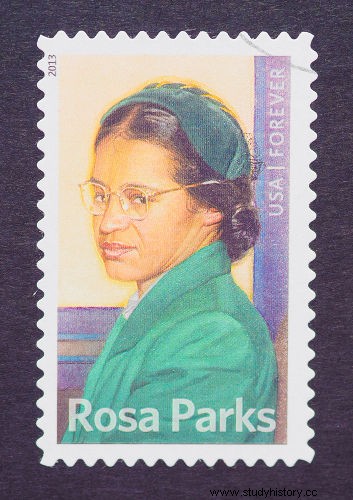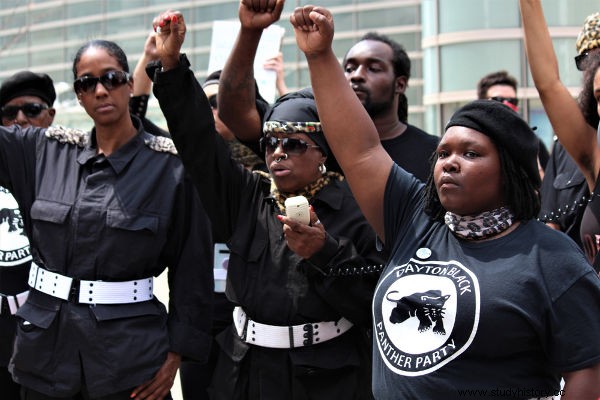The Black Panthers were an American political party that emerged in defense of the African-American community. This party originated, at first, as a group dedicated to the combat against police violence against blacks during the 1960s, in the context of the civil rights movement in the United States.
The Black Panthers took on a revolutionary ideology that advocated for armed self-defense of black people against state violence against this community. They had a project of self-management social , that is, the African-American community should govern itself, and they defended the realization of social projects to assist the poorest.
The Black Panthers suffered considerably from the repression of the US government. The FBI took numerous actions to weaken the group, which eventually disappeared in the 1980s. One of the symbols of the Black Panthers' struggle was the fist raised in the air .
Civil Rights Movement

Until the 1960s, the United States was marked by intense discrimination racial . It was common, until this period, for blacks to be forbidden to frequent certain places, such as some restaurants and shops. There were places that separated white and black bathrooms, and even drinking fountains were separated that way.
Prejudice in the United States was an “inheritance” from the periods of slavery in that country. Since its end, with the Civil War, the separation between blacks and whites in society was evident. Many blacks had their right to vote restricted, the poverty they were forced to live was enormous, as was the violence suffered, mainly by the police.
All of this led to the civil rights movement , started in the 1950s, when Rosa Parks he refused to give up his seat on the bus to a white man. From there, a series of protests by black people spread across the United States and great leaders emerged to demand an end to the segregation that existed in the country.
Martin Luther King Jr. was one of those names. He was a Baptist pastor who lived in Georgia, southern United States, and advocated that the struggle of blacks should be for civil disobedience and peaceful protests. There were also those who defended armed self-defense on the part of blacks, as was the case with the Nation of Islam , a group that advocated the separatism of black Americans. In this scenario of social effervescence, the Black Panthers emerged.
Login also :Discover the life of Malcolm X, one of the most well-known members of the Nation of Islam
How did the Black Panthers come about?
The Black Panthers were founded in 1966 by two black college students named Huey Newton and Bobby Seal . Both lived in Oakland, California and created this group as a way to combat police violence . This is because, with the context of protests, this type of violence intensified, since many whites, moved by racism, reacted with violence against the protests.
So these two students decided to create an organization to monitor police operations and prevent violence against African Americans from being carried out. The big difference is that the Black Panthers intended to accompany these operations armed with weapons. They justified it through the 2nd Amendment of the United States Constitution, which gave citizens the right to bear arms.
The Black Panthers, in their early years of acting, acted in an intimidating way against people who were racist. However, little by little, the group developed and adhered to new guidelines, until it became a party.
Black Panther Ideology

Since their founding, the Black Panthers had a program , known as the Ten Point Program , which outlined what they wanted and what they believed in. Focused, at first, on combating police violence, the group developed and received new ideological influences. The main influences of the Black Panthers were Frantz Fanon and Karl Marx .
Over time, the group engaged in social actions and ended up taking an overtly Marxist platform , being, therefore, critical of capitalism . The Black Panthers also advocated the establishment of a society self-managed , in which the poor (especially blacks) would govern themselves.
The Black Panther Ten-Point Program was eventually made public in 1967, and contained the following requirements|1| :
WHAT WE WANT
-
We want freedom. We want power to determine the fate of our black community.
-
We want full employment for our people.
-
We want an end to the thievery of white capitalists against the black community.
-
We want decent houses to house human beings. We want decent education for our people. An education that exposes the true nature of the decadence of American society. We want our true history and our role in today's society to be taught.
-
We want a decent education for our people. An education that exposes the true nature of the decadence of American society. We want our true history and our role in today's society to be taught.
-
We want all black men to be exempt from military service.
-
We want an immediate end to police brutality and murders of black people.
-
We want freedom for all black people in federal, state, district and municipal prisons and jails.
-
We want all black people brought on trial to be judged by their peers or people from their black communities, as defined by the United States Constitution.
-
We want land, bread, housing, education, clothes, justice and peace.
Black self-determination, access to basic survival items, and an end to violence against them were the Black Panthers' greatest demands.
Forms of Black Panthers
Between 1966 and 1968, the Black Panthers ceased to be a regional acting group and gained projection national . Two important moments for them took place in 1967:the first, when there was an invasion of the City Hall by 30 party members, at a time when the State of California was debating the ban on carrying weapons; and the second, when Huey Newton was arrested for murdering a police officer.
As mentioned, the group initially acted as a patrol guarding poor neighborhoods in Oakland to prevent police violence. With the national projection, Black Panther cells were founded in different parts of the United States, causing their ideology to spread.
As the Black Panthers gained influence, the conditions for implementing social works expanded. So they set up schools and hospitals community who provided free services to poor people, especially blacks and Latinos. They also carried out the food distribution and transported the children to school . In these schools they taught US history from the party's own perspective.
In their heyday (late 1960s), the Black Panthers had up to five thousand members and had over 30 committees in different cities in the United States|2| . They also had the support of a significant portion of African Americans. This popularity was the result of the party's efforts to combat social violence and promote social equality.
Login also :Learn about the history of concentration camps for Japanese in the USA
End of the Black Panthers
The Black Panther Party officially came to an end when it was dissolved in 1982. Its demise, however, was the result of a long process of attrition caused by the Federal Bureau of Investigation (FBI) , the department responsible for criminal investigation in the United States. FBI involvement led to Black Panthers being included in the Counterintelligence Program .
This program aimed to disarticulate and weaken movements considered subversive, especially those with a progressive platform. Through him, the FBI infiltrated agents into the Panthers who weakened and demoralized . In addition, the FBI managed to plant dissidence inside the party.
Violence against the Black Panthers has also increased considerably, and dozens of party members have been killed every year. Many were arrested, and the number of lawsuits that the party had to face in court meant that it also faced serious financial problems.
Finally, disagreements and leadership problems caused the party to be definitively weakened in the 1970s, leading to its dissolution , in 1982.
Notes
|1| The Black Panther Party's Ten-Point Program. To access, click here [in English].
|2| CARPINI, Michael X. Delli. Black Panther Party:1966-1982. To access, click here [in English].
Image credits
[1] Madison Muskopf and Shutterstock
[2] catwalker and Shutterstock
